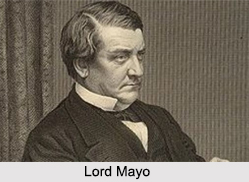 Richard South well or the 6th Earl of Mayo was known as Lord Mayo in India. He was styled by Lord Naas from 1842 to 18767. He was the statesman or viceroy of India and also a prominent member of the British Conservative Party form Dublin in Ireland. He began the procedure of decentralization of finance. The policy of non-intervention was followed by him in matters of foreign affairs. He opened up a college known as “Mayo College†in Ajmer for enlightening the students of the aristocratic families.
Richard South well or the 6th Earl of Mayo was known as Lord Mayo in India. He was styled by Lord Naas from 1842 to 18767. He was the statesman or viceroy of India and also a prominent member of the British Conservative Party form Dublin in Ireland. He began the procedure of decentralization of finance. The policy of non-intervention was followed by him in matters of foreign affairs. He opened up a college known as “Mayo College†in Ajmer for enlightening the students of the aristocratic families.
Early Life of Lord Mayo
Lord Mayo was born on 21st February in the year 1822 in Dublin. He was the eldest son of 5th Earl of Mayo also known as Robert Bourke and his wife, Anne Charlotte. He received his education from the Trinity College in Dublin.
Lord Mayo and India"s First Census
The first census of India was carried out in 1871 under Lord Mayo"s orders. The statistical survey of India took its shape by him along with directions of William Wilson Hunter. He produced a printed account for every town, village and district that was compiled carefully after local inquiry. It disclosed the whole social and economic facts in the life of people. This was the most exhaustive work since the “Ain-I-Akbari.â€
Intervention policies of Lord Mayo
He continued the policy of Non intervention followed by his immediate predecessors and through diplomatic maneuver secured the good will and friendship of Sher Ali, Ameer of Afghanistan, who met the viceroy at Ambala in 1869. Mayo secured the Russian recognition of the Oxus as the Northern Afghan border. Perhaps his great achievement was the reform of financial management. He increased the salt duty and income tax, enforced economy in the public administration, introduced decentralized finance with provision for fixed block grants for five years to the provincial governments and substantially improved the finances of the country. Formerly the center controlled all finances and the provinces had to make out cases for allocation of funds and spent what they could get.
 Other Policies of Lord Mayo
Other Policies of Lord Mayo
He consolidated the frontiers of India and reorganized the country`s finances; he also did much to promote irrigation, railways, forests and other useful public works. While visiting the convict settlement at Port Blair in the Andaman Islands, for the purpose of inspection, he was assassinated by Sher Ali, a Muslim convict.
Assassination of Lord Mayo
The vigor of Lord Mayo had defied the distances and climate in India. He studied the requirements of farthest provinces of empires anxiously but unfortunately he encountered a short assassin by Sher khan. Sher khan was a convict at the Andaman Islands in 1872. He was also known as the first “Jihad.†He declared himself not-guilty when convicted. Lord Mayo was succeeded by an acting Governor General and viceroy John Starchey. Starchey was followed by Lord Napier in the same year in 1872.
Memorials of Lord Mayo
A statue of Lord Mayo was unearthed at Jaipur in India in 2007. Earlier, the statue had been installed inside the premises of Mayo Hospital which is currently known as Mahilya Hospital in Jaipur. The statue is 9 foot tall made up of iron weighing around 3 tons It was built by the Maharaja Ram Singh Ji of Jaipur. It was a tribute to him after the assassination. R.Monti and J. Forsyth. In order to prevent the statue from vandalism, it was buried inside the premises of Albert Hall Museum in Jaipur. After a time span of six decades the statue got unearthed by the Jaipur Mayo Alumni Chapter on 29th May in 2007 to the Mayo College where it is installed at present.






































